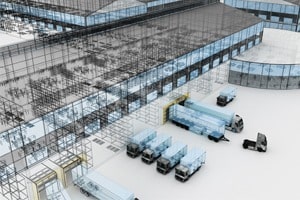What is warehouse planning?
Good warehouse planning plays a major role in ensuring that a warehouse can achieve the greatest possible economic success. This is influenced by various factors, which makes it a very complex process.
In general, however, warehouse planning can be summarized in six areas:
- Acceptance
- Shipping
- Quality management
- Storage
- Order entry
- Customization of loading units
Receiving, storage and dispatch in warehouse planning
These areas can be categorized into three storage areas. Incoming goods as well as quality and interface control take place in the receiving department. The delivered goods are also repacked onto loading units adapted for the shelves used.
Storage usually takes up most of the storage space. Here, the goods are stored in various types of shelving or on the floor. Depending on the turnover rate and value of the goods, it is stored in different places in the warehouse.
In the dispatch area, orders for retrieval and picking are received and processed. As unscheduled peaks in demand can occur, this area must also be correspondingly large.
The prerequisite for sustainable economic activity
In times of globalization and international flows of goods, organization is an essential element for operating efficiently. For industrial companies, e-commerce firms or mail order companies, aspects of warehouse planning play a particularly important role. After all, when in doubt, a warehouse must grow with the company and continuously adapt to changing conditions.
Basics: these three basic tasks must be taken into account in warehouse planning
Consumers are increasingly demanding transparency and predictability, and the ideal of live tracking is shaping customer behavior in some areas. Optimized warehouse planning helps focus on this aspect and generate competitive advantages. Let’s take a look at the three core areas of warehouse planning first.
Acceptance
Before the goods are handled in the warehouse, they must be accepted, including a quality check. This is where we check whether the product meets the desired properties and specifications. Typically, the goods receiving area is located next to the unloading area, and there are also areas for unscheduled goods receipts.
Storage
At the heart of warehouse planning is the storage itself, because this is where optimum space utilization is important. Central warehouses are divided into several sections, which in turn influences the turnover rate. Depending on the product or product type, this creates the conditions for achieving the highest possible average values. Block storage areas that are geared towards speed and less towards accessibility are suitable for high throughput. One example of this is compact storage systems. Shelving systems, on the other hand, tend to be designed to keep goods for longer.
Shipping
In order to ensure the internal and external distribution of stored goods, the dispatch area is geared towards order compilation and packaging. This area is particularly critical to success, as good warehouse planning is reflected in the seamless integration of the processes that end here. This is ensured with the help of a warehouse management system (WMS).
From idea to implementation: these steps shape warehouse planning
Warehouse planning is always integrated into factory planning, depending on the underlying structure and therefore sometimes restricted by external constraints. While warehouse organization is characterized by warehouse control and storage location management, questions relating to storage and transport technology depend on shelf types (direct/indirect) or warehouse operating types. Further detailed questions relate to the storage unit, including storage aids and stored goods, as well as the warehouse layout, structured by coarse and fine layout.
The following diagram shows the typical warehouse planning process – from A to Z:
- At the beginning, the objectives and requirements are listed, for example with reference to transport route lengths or load capacities. Existing warehouse processes are also integrated here.
- Warehouse planning is based on a basic determination, so that existing data material is evaluated and analyzed. Typically, ABC/XYZ analyses are carried out for this purpose.
- The focus then turns to the warehouse organization, integrating the warehouse process as such, the warehouse strategy and partial aspects of the work organization of all warehouse employees.
- After running through various scenarios, warehouse planning now moves on to dimensioning and forecasting future stock trends. This also determines the choice of storage or transportation technology that is used.
- Finally, the warehouse layout is defined based on the previously determined warehouse dimensions and basic parameters.
Tip: evaluate inventory data from warehouse management software to plan new storage areas
Optimum warehouse and material flow control forms the backbone of every company, regardless of the industry. With a high-performance warehouse management system (WMS), you are able to control and analyze all processes relating to storage, retrieval and transfer. This also provides reliable data that is required for new warehouse planning.
Click here to continue to our warehouse management software

